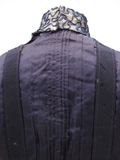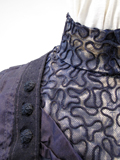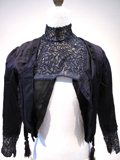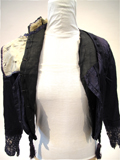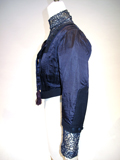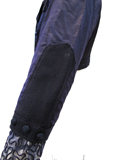This blue silk satin Edwardian bodice has a fully boned foundation. The neckline is filled by a lace partlet beautifully decorated with soutache; the bottom of the sleeves match this trim. It has a belt and is trimmed with navy blue wool flannel. The lining is made from black cotton batiste.
Construction
As is typical of the Edwardian period, the bodice has a boned foundation that keeps the bodice tight to the body. The foundation is made of black batiste and closes right over left at center front with hooks and eyes (see Figure 1). The selvages of the batiste are used at center front indicating the straight of grain at the center. The front has a waist dart and is in one piece wrapping around with the side seam positioned towards the back. The side seam angles even more towards the back at the waist (see Figure 5). The back of the bodice is composed of a side back and a center back piece. There is a seam at center back although the straight of grain is aligned with the center. The only reason I can see for that is to conserve fabric on the part of the dressmaker.
The back foundation seams are finished by pinking. The center back seam is pressed open and the side back seams are pressed away from center back. The foundation connects to the silk bodice at the side, shoulder and armscye seams. All of these seam allowances are bound with 1/4" black silk bias. The shoulder and side seam allowances are pressed open and the armscye allowances are bound together. The waist of the silk bodice and the foundation are connected, turned to the inside and finished with 1 1/4" navy bias.
The foundation has seven 1/4" steel bones located at the side back seam, side seam, front waist dart, and one on the left center front opening. Channels made from the dart allowance and the center front facing encapsulates the front bones. Black batiste casings are used for the side back bones and black cotton twill encases the bones at the sides (see Figure 2).
| Figure 1: Front Bodice | Figure 2: Inside Back Bodice |
 |
 |
The outside of the bodice is made of a light weight silk satin with darker navy flannel trim. Numerous tucks are found on the front and back of the bodice ranging from 1/8", 3/8" or 5/8" in width. The back is in one piece with the center on the fold. The bodice fits snugly to the foundation across the shoulder blades. To make the waist of the satin fit the foundation the space in between the tucks is pleated. The fullness is dispersed so that all of the tucks end up with no space in between at the waist and any extra fullness hidden behind the wool trim (see Figure 3).
| Figure 3: Back Bodice |
 |
The front of the bodice has a slight pouter pigeon belly that extends slightly past the flannel belt (see Figure 4). The tucks are pleated in at the waist in a similar fashion to the back except that the fullness is concentrated mostly in the center front. The bodice has a square neckline and close right over left with hooks and bars. The center front closures are concealed within the tucks. The tucks on the front and back are pressed away from the center with exception of those on either side of center front. These two tucks are pressed towards center front to assure the hooks remain hidden.
The front is in one piece connecting to the foundation at the side seam. The side seam, as mentioned in the foundation description, is slanted creating a smaller waisted look in the back. If measuring from under the arm where side seams typically go on modern clothing, the bodice's seam is located 1 3/4" towards the back at the armscye and 2 1/4" back at the waist (see Figure 5).
| Figure 4: Front Bodice | Figure 5: Side Bodice |
 |
 |
Neckline and Décolletage
The décolletage is covered by a soutache lace partlet. The soutache lace is comprised of 1/8" wide soutache sewn in a vermicelli pattern onto navy scoured net. The net is flatlined to another net with wider holes and to white silk. The partlet is sandwiched between the navy silk neckline and the foundation. It is sewn to the silk and the batiste on the right neckline (see Figure 6). The left side of the parlet is finished with 1/4" navy silk bias and connects to the left foundation shoulder seam with hooks and bars. The left silk neckline covers the lower portion of the left partlet and connects with hooks and bars (see Figure 7).
| Figure 6: Partlet | Figure 7: Neckline |
 |
 |
The neckline of the bodice is finished with 1/4" navy silk bias. A separate 2” wide soutache-decorated lace collar is hand-tacked to the finished neckline. The collar is attached to the neckline from center back around the left to the shoulder of the partlet. The collar closes at the center back with hooks and bars (see Figure 8). The top and bottom of the collar are finished with 1/2" cream hem tape. The center back edges are turned in on themselves. There are four 2" long, 1/4" wide cane bones loosely attached to the collar. These are placed at center front, center back and sides and are encased in black silk taffeta (see Figure 9).
| Figure 8: Undercollar | Figure 9: Inside Neckline |
 |
 |
Sleeves
The bodice has a one piece, 3/4 length sleeve made of the same navy silk (see Figure 10). The cap of the sleeve fits smoothly into the armscye with the seam of the sleeve positioned 2 3/4" to the front of the side seam. The sleeve seam is pressed open and overcast. The hem of the silk is turned under 1-1/8" and finished with wool trim which is edgestitched on top of the sleeve.
The undersleeve extends to the wrist. It has a slightly closer fit than the oversleeve with the seam in the same position. The section of the undersleeve that is hidden beneath the silk sleeve is made of black cotton batiste. The lower portion is of the soutache-decorated lace (see Figure 11). The undersleeve seam is left open at the wrist for 1 3/4" and the hem finished with 1 1/4" navy silk bias (see Figure 12). The sleeve opening fastens with two hooks and eyes. The seam allowance of the lace is pressed open, turned under and slip stitched, while the batiste seam allowance is pressed open and pinked.
| Figure 10: Sleeve | Figure 11: Lower Sleeve | |
 |
 |
|
| Figure 12: Sleeve Hem | ||
 |
||
Trim
Dark navy wool trim, 1-1/8" wide, decorates the bodice throughout. The trim is seen vertically alongside the tucks on the front and back. The trim stems from the waist, one on each side of center back, up into the shoulder seams (see Figure 3). The front trim goes from the shoulders down along the square neckline, mitering to continue along the neckline for 3" and then mitering again to go straight to the waistline (see Figure 4). Horizontal strips of the same width trim edge the silk sleeve hem. A wool pentagon shape, 3" wide- 6 1/4" long, is on the silk sleeve (see Figure 10). It is positioned at the center front above the horizontal trim. All the wool trim edges are folded under and then edge stitched to the bodice.
| Figure 13: Belt |
 |
A 1 1/2" wide wool belt is tacked on top of the bodice waist. The belt has a hymo interfacing and is cut in a point at the center front overlap (see Figure 13). The point extends past the center front of the bodice 1" and hooks to its counterpart. The belt edges are folded under and edge stitched. There is no lining to the belt so the hymo can be seen when looking underneath where the belt is not tacked down.
There is a navy silk tie embellishing the front square neckline. The tie is 1 1/2" wide and the edges begin on either side of the neckline, 1/2" above the squared corners. The tie knots at center front and has two 3" long navy tassels hanging from the ends (see Figure 14). One end of the tie is sewn at the right neckline between the silk bodice and the partlet. The end coming from the left has a bar that attaches to a hook under the silk bodice at the left neckline (see Figure 7).
Another typical decorative element of the time is buttons. The buttons found on this bodice are done with a lace needle technique. They are 1/2" wide with the navy thread done in a spider web design. Three are found on each oversleeve sewn on the horizontal trim directly beneath the pentagon wool piece. The buttons are equally space under the pentagon. Another three are found on either side of the front square neckline. The buttons arespaced 1" apart from each other and are placed along the vertical wool trim (see Figure 15).
| Figure 14: Tassel | Figure 15: Buttons |
 |
 |
Summary
With all of these elements combined the bodice has a very delicate, feminine appeal. The convoluted closures give a great example of the creativity dressmakers of the period had when concealing openings. There is so much detail in this bodice it is a wonderful piece to have as a research tool.
The silk has deteriorated extensively with time and rips easily with even the slightest movements. Many of the bones are now exposed and the wool is moth eaten in multiple places. Due to its fragile condition great care was taken while researching the garment. Diligence will also be used to preserve this vintage piece in the UNC-Chapel Hill Costar collection as long as possible.
©Amanda Phillips, 2008


